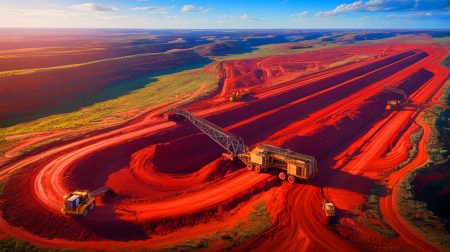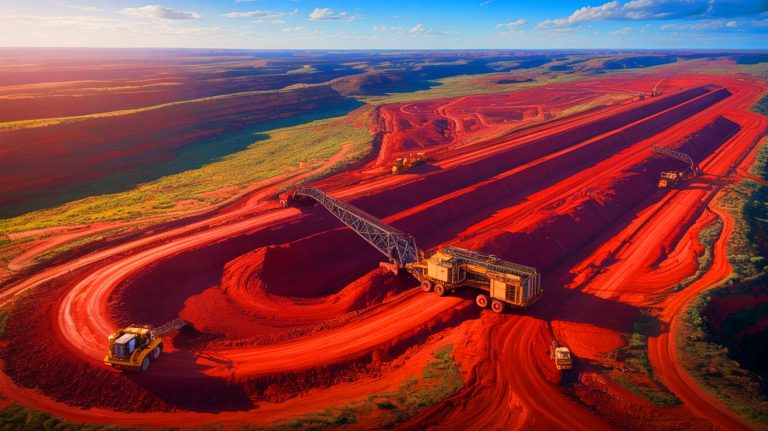| IN A NUTSHELL |
|
The recent discovery of an enormous iron ore deposit in Western Australia’s Pilbara region has sent ripples through the global economic and scientific communities. Valued at nearly $6 trillion, this deposit boasts iron concentrations exceeding 60%, positioning it as one of the richest ever found. This groundbreaking find is poised to challenge existing geological theories and reshape the international trade landscape. As scientists and economists alike scramble to comprehend the full implications, this discovery promises not only significant economic benefits but also new insights into Earth’s ancient geological processes.
The Heart of the Pilbara: A Treasure Trove of Iron
The Pilbara region, long known for its rich mineral resources, has unveiled a discovery of unprecedented scale. This new iron ore deposit is not only the largest in the world but also among the richest, thanks to its high iron concentration. The Hamersley Range, a familiar name in mining circles, has revealed deeper secrets than previously imagined. Modern technology has allowed geologists to re-evaluate the region’s mineral wealth, uncovering layers of iron ore that were once thought impossible.
Geologists have revised their understanding of the region’s history, suggesting that ancient supercontinent cycles played a significant role in creating these mineral-rich formations. The estimated age of these formations has been adjusted from 2.2 billion years to approximately 1.4 billion years, highlighting the dynamic nature of Earth’s crust over geological time scales. This discovery not only enhances our knowledge of Earth’s history but also sets a new precedent for uncovering mineral deposits in similar geological settings around the world.
Technological Advances Uncover Hidden Depths
The discovery of this remarkable deposit was made possible through the use of state-of-the-art technology. Advanced isotopic dating and chemical analyses revealed the deposit’s true potential, uncovering iron concentrations that far exceed initial estimates. These technological breakthroughs have significant implications for the mining industry, promoting more efficient and environmentally sustainable practices.
By optimizing extraction processes and minimizing waste, these technological advances offer a glimpse into the future of mining. The increased efficiency could lead to reduced environmental impact, aligning economic interests with ecological sustainability. As these technologies continue to evolve, they promise to pave the way for further discoveries, enhancing our understanding of Earth’s mineral resources and potentially leading to the identification of other significant deposits worldwide.
Global Impact on the Iron Market
The discovery in the Pilbara region is expected to have a profound impact on the global iron market. Australia, already a major player, is set to strengthen its position as a leading supplier. The sheer scale of this deposit could influence global iron prices, prompting nations dependent on iron imports to reassess their economic strategies. This, in turn, could lead to the formation of new trade alliances and partnerships.
Beyond the immediate economic impacts, this discovery challenges long-standing geological theories. By studying the formation processes of this deposit, researchers aim to deepen their understanding of Earth’s surface and mineral wealth. These insights could revolutionize the field of geology and encourage further exploration in similar geological environments worldwide, potentially leading to more groundbreaking discoveries.
Rewriting the Geological Narrative
The newfound deposit not only holds economic promise but also offers an opportunity to rewrite geological history. By questioning established scientific beliefs, this discovery encourages geologists to delve deeper into the ancient processes that formed such significant mineral deposits. The insights gained from this exploration could lead to further breakthroughs in geology and mining.
As researchers continue to explore the Pilbara region, the potential for uncovering more vast mineral deposits grows. This discovery serves as a catalyst for future research endeavors, opening up new opportunities for exploration and discovery. As the scientific community works to unravel the mysteries of the Pilbara, one can only wonder what other secrets lie hidden beneath Earth’s surface, waiting to reshape our understanding of the planet’s geological past and future.
The Pilbara discovery raises intriguing questions about the future of global trade and geological exploration. As the world considers the implications of this monumental find, what other hidden treasures might lie beneath our feet, ready to challenge our perceptions and transform our world?







Wow, $6 trillion in iron? That’s enough to build a life-size Iron Man suit! 🤖
Hope they plan to mine it sustainably. The planet doesn’t need more destruction.
Great article! But why would this cause US-China tensions specifically?
Can someone explain why this is a big deal? Like, we already have a lot of iron, right?
So, will iron prices drop or skyrocket because of this?
Finally, something that might actually challenge the oil industry!
Isn’t this just a way for big corporations to get richer? 🤔
More iron means more jobs, I hope. The mining industry could use a boost.
How reliable are these geological theories they’re challenging? Seems like a big claim.
Has anyone thought about the environmental impact of exploiting such a large deposit?
What does this mean for the steel industry? Are we going to see cheaper products?
Absolutely mind-blowing! The scale of this find is hard to grasp. 🌍